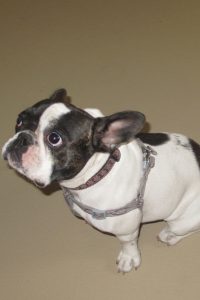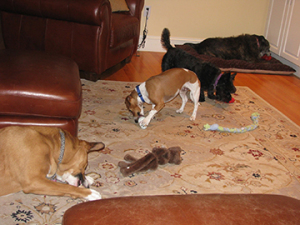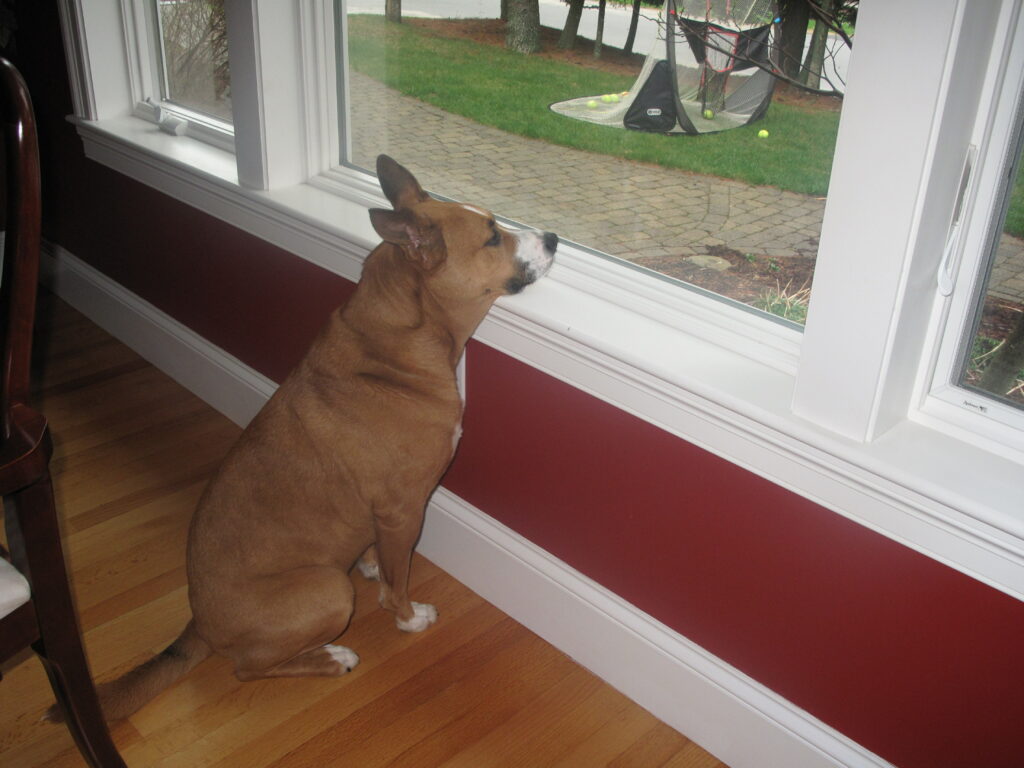Will your dog likely develop Anxiety when home alone?
If you suspect your dog is suffering from a form of Separation Anxiety, contact your vet, as many of the symptoms can also be medical in nature. Your vet may include a complete blood cell count, biochemistry, thyroid test, and urinalysis to gather more information on what may be causing some of your dogs behavior changes.
So, what are the signs you should look for?

Is your dog slightly environmentally insecure or worried in new places? Does your dog hesitate when walking down some streets or new parks? Do her eyes become enlarged as she scans the area often? Maybe her body looks compressed, or she moves slower then normal with stiff leg movement. Maybe she sits and refuses to move forward, yet if you turn around, she quickly moves in the direction of home.

Is your dog somewhat sound sensitive? Observed by your dogs startle reflex when a truck rumbles in the distance, you drop something, or you raise your voice. These dogs may run to another room or cower. They may also become tense or lower their body and head, show the whites of their eyes and push their ears way back. Maybe you need to medicate your dog during fireworks. These dogs often go into flight mode and try to hide somewhere safe. They may stay in a state of anxiety for 30 minutes for more.

Is your dog shy or worried about strangers? Shown by your dogs hesitation to enter guests space. Maybe your insecure dog shows his anxiety by greeting visitors in an over the top excited, jumpy wiggly or mouthy manner. Moderately fearful dogs may rush the door, barking rapidly. Or maybe your dog has become increasingly territorial of your home or car when people approach or are visible. If you dog is unable to calm quickly after being stressed or aroused, they are showing you that they struggle to rebound from a stressor.
If your dog exhibits any of the above character traits then your dog is more likely to develop a form of Separation Anxiety, than a dog who is:
- Environmentally confident
- Demonstrates no Sound sensitivity
- Is Social with all people
- Can Rebound quickly after being stressed
- Is Patient by nature
Distinguishing between SA and Isolation Stress:
Separation Anxiety: Is described as a dog who is unable to cope when their human is away. Not just anyone is able to comfort these dogs as they have bonded with one or two individuals. These dogs often have low environmental confidence, low sociability with new people, and are persistent in nature. Their inability to rebound keeps them in a state of anxiety longer. If the dog is vocal in nature, his anxiety may manifest with barking, if he is high energy, chewing may manifest. They often become extremely excited and aroused when familiar people enter the home and are often labeled velcro dogs.
Isolation Stress: Is described as a dog who is fearful of being alone. Their fear of other stimuli is heightened when no one is there to make them feel safe. These dogs often have low environmental confidence, and may exhibit some form of sound sensitivity. These dogs are often persistent in nature and therefore whine or pace longer then a patient dog. Vocal dogs may bark and high energy dogs may begin to chew on items nearby.
Here are a few examples to give you a better picture of what may occur.
Example: Max is fearful of most men and will bark or growl at them when they come too close. He is also very protective of his house and car. When alone in the home and he hears a man’s voice outside, he begins to slowly and stiffly pace about the rooms, he often drools, and will occasionally urinate in the home. This isolation stress will subside when the voices stops as his rebound time is fairly good.
Example: Lucy is a shy pup who takes a few minutes to warm up to  strangers. On walks, she often hesitates, scans her environment and only wants to sniff the ground near her. If she hears a siren or any medium/high pitched noise she pulls towards home. Lucy’s family has recently moved into a new home. She begins to whine when left alone for the first time, which leads to her barking, pacing and scratching at the door. When her familiar humans come home she greets them with such jumpy enthusiasm they scold her and then see the door damage and scold her even more. Lucy’s low environmental confidence and sound sensitivity have contributed to her stress and anxiety of being alone.
strangers. On walks, she often hesitates, scans her environment and only wants to sniff the ground near her. If she hears a siren or any medium/high pitched noise she pulls towards home. Lucy’s family has recently moved into a new home. She begins to whine when left alone for the first time, which leads to her barking, pacing and scratching at the door. When her familiar humans come home she greets them with such jumpy enthusiasm they scold her and then see the door damage and scold her even more. Lucy’s low environmental confidence and sound sensitivity have contributed to her stress and anxiety of being alone.
Example: Mika is a high energy German Shepherd mix who will play fetch for an hour and will persist to find the ball when it goes into the tall grass. Mika is also verbal and barks when aroused or frustrated. When left alone, she runs and barks in the home after her owners leave for nearly 10 minutes, then chews her toys or an occasional pillow or article of clothing for 10-15 minutes and then climbs in her bed for a three hour nap. Mika is not exhibiting anxiety when alone, yet her high energy, verbal temperament and her enjoyment of chewing can mimic that of anxiety.
To determine these dogs anxiety levels, we set up a camera to determine what the triggers were, how their behavior changed and if they were able to recover.
A successful Behavior Modification Program will use counter conditioning and desensitization to slowly help these dogs become comfortable in their environment and cope with being alone.
Counter conditioning is about changing the associations that the dog already has to something. When we desensitize our dogs, we make them less sensitive to what they fear. Conditioning for this training purpose is about building their confidence and giving them the tools to feel safe when alone.
Basic Plan: Disassociate each of your routine habits before you leave so your dog stays calmer. Example: If putting on your shoes is a reliable predictor for you leaving, put them on many different times a day. Pick up your keys, walk around and sit them down, without looking at your dog. You get the idea. Stop to breathe several times to help lower your dogs anxiety and aid in his resiliency.
Condition: Help your dog become more confident in your home by having many short positive training sessions each day to a particular bed/mat or place.
- Condition your dog to go to this bed/place, using a positive approach. This is never forced or it will have a negative association and impede your goal.
- Build some duration on the mat/place by rewarding your dog often for staying on his mat while you go across the room. I never say “stay” I just let the dog learn that when he is on his mat, good things happen. Sometimes when I return I drop 10 treats on his mat to increase association.
- Condition your dog to his favorite interactive food toys using high value food items. This conditioning must be done for several days before offering it to them and walking out. If your dogs association is not strongly compelling and positive, this toy or treat may

Four pups enjoying daily kong time
become a predictor of you leaving, and increase your dogs anxiety. - Increase your dogs daily physical and mental exercise.
- Teach your dog a cue, “Be good” or I’ll be back”. This gives your dog feedback, that you will be gone but will return. You can begin to teach this in small pieces while you leave your dog from one room and go to another and return, reward with calm praise. Over time you gradually increase the time you are gone and always return with calm praise.
- Generalizing this behavior to different rooms, the car, deck, yard, vets office and more will aid in your dogs coping skills.
- Add white noise to drown out noise for sensitive dogs.
- Talk to your vet about medication as it is often helpful for dogs who are environmentally worried, or sound sensitive.
Summary: I hope you now have a better idea of why some dogs are predisposed to and suffer from Separation Anxiety Issues. What to look for in your dogs temperament, and some positive intervention techniques to support your dog. Always be mindful that an underlying medical condition may also be a factor. Inform your vet of your concerns, and seek a professional Dog Behavior Consultant to aid in your dogs training plan.
Dogs who engage in chewing when alone will benefit from a variety of toys options. Interactive toys that encourage dogs to work for their food keeps their mind engaged. Chew toys should be safe, appealing, and virtually indestructible. Many chew toys can be stuffed with dog food or healthy treats to increase their appeal.
Below are a few toy options for you to consider, listed by the Toy Name Description Manufacturer/Website
Bustercube Hard plastic cubes with inner maze. Slowly dispense kibble when rolled Kruuse www.bustercube.com
Chewber Durable rubber frisbees designed for chewing, tossing and tugging Chewber www.chewber.com
Classic Kong / Treat Ball Rubber toys with various hollow areas that can be stuffed with food Kong Company www.kongcompany.com
Nylabone Synthetic and edible bone shaped chew toys Nylabone www.nylabone.com
Orka Ball / Orka Jack Pliable synthetic hollow toys that can be stuffed with treats Petstages www.petstages.com
TireBiter nylon tire-shaped toy can be tossed, tugged, and stuffed with spreadable food Mammoth Pet Products www.mammothpet.com


